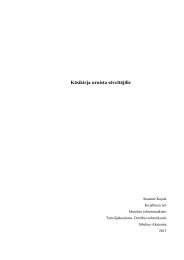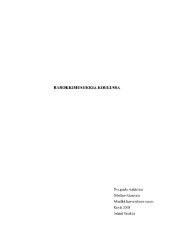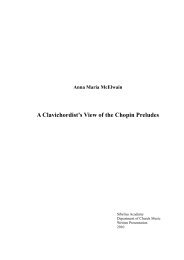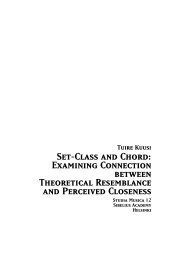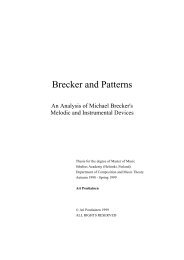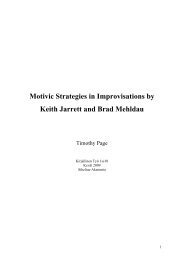The Unfinished Piano Sonatas of Franz Schubert Javier ... - Ethesis
The Unfinished Piano Sonatas of Franz Schubert Javier ... - Ethesis
The Unfinished Piano Sonatas of Franz Schubert Javier ... - Ethesis
You also want an ePaper? Increase the reach of your titles
YUMPU automatically turns print PDFs into web optimized ePapers that Google loves.
V Auf dem Weg zur großen Sinfonie<br />
similarities in the development <strong>of</strong> <strong>Schubert</strong>’s output in the three most important<br />
instrumental forms <strong>of</strong> the classical period: the symphony, the string quartet and the<br />
sonata for solo piano. During the ‘learning years’ <strong>of</strong> his youth, approximately from 1815<br />
to 1818, <strong>Schubert</strong> cultivated these forms intensely, mostly with the Viennese classics as<br />
his main models. But it was not until 1824, after a long learning process in which opera<br />
played an important role, that he returned to the genre with stunning results. Apart<br />
from the C major <strong>Piano</strong> Sonata (D840), <strong>Schubert</strong> would finish all <strong>of</strong> the instrumental<br />
pieces in sonata form that he embarked on: seven solo and two ensemble sonatas, two<br />
big piano trios, three monumental string quartets, a string quintet and his long-desired<br />
‘grand symphony.’<br />
<strong>The</strong> <strong>Piano</strong> Sonata in C major (D840) is the last <strong>of</strong> the unfinished piano<br />
sonatas and one <strong>of</strong> the most important sketches that <strong>Schubert</strong> left us. <strong>The</strong> Sonata was<br />
dubbed ‘Reliquie’ upon publication in 1861 because it was mistakenly assumed to be<br />
<strong>Schubert</strong>’s final piano sonata. <strong>Schubert</strong> worked on it in the spring <strong>of</strong> 1825, almost<br />
simultaneously with the Sonata in A minor (D845). Both pieces not only bear clear<br />
thematic resemblances (Ex. 1. and 2.), they are also remarkable for their striking formal<br />
structure, especially in their opening movements. It seems likely that <strong>Schubert</strong> intended<br />
these two works to be part <strong>of</strong> a set <strong>of</strong> four, completed by the coming D major Sonata in<br />
the summer (D850) and the G major Sonata <strong>of</strong> the following year (D894). <strong>The</strong> A minor<br />
and the D major sonatas were published in 1826 as ‘Première Grande Sonate’ and<br />
‘Seconde Grande Sonate’ respectively, and the autograph <strong>of</strong> the G major Sonata bears<br />
the heading ‘IV. Sonate.’ 10 <strong>The</strong> question arises: which sonata was intended as the<br />
missing third? It is probable that the C major was originally part <strong>of</strong> the set, but its<br />
incomplete state (with possibly no intention <strong>of</strong> <strong>Schubert</strong> himself to finish it) may have<br />
led to his revision <strong>of</strong> the Sonata in D-flat major <strong>of</strong> 1817 (D567) ready for future<br />
publication. As we saw in chapter 2, the revised version (D568, in E-flat major) is not<br />
merely a transposition, it is a thorough revision. In addition to some formal changes,<br />
especially in the outer movements (which, as we have noticed, were problematic for the<br />
younger composer), <strong>Schubert</strong> added a fourth movement and presented it as a ‘new’<br />
piano sonata. In any case, the importance <strong>of</strong> the ‘Reliquie’ cannot be overestimated. We<br />
might easily say that, in a similar way that the ‘<strong>Unfinished</strong>’ Symphony opened up a new<br />
phase in <strong>Schubert</strong>’s symphonic work, the C major Sonata marked the beginning <strong>of</strong> a<br />
new era in his piano sonatas. <strong>The</strong> formal innovations, the harmonic audacities (even by<br />
<strong>Schubert</strong>’s standards!), the massive textures and the pianistic colour <strong>of</strong> this composition<br />
are strikingly new, revealing a rather different piano composer – one more adventurous<br />
in his ‘studies’ towards the symphonic goal.<br />
84




